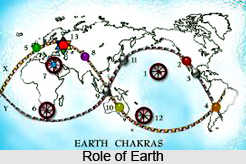 The Chakras are energy centers of body that are considered flowerlike, which open and close as well as spin like wheels. To study chakra is as if going on a journey. It is a journey through the layers of one`s own life. It is a journey through the life, through the worlds within an around one self. It begins in the own body. It begins now, wherever the person is. It is the human being`s own personal quest. The journey could take months, years, or lifetimes, so one should have patience in life. There`s actually a long way to go. Earth is the source of all the spiritual energy, which supports the whole body system
The Chakras are energy centers of body that are considered flowerlike, which open and close as well as spin like wheels. To study chakra is as if going on a journey. It is a journey through the layers of one`s own life. It is a journey through the life, through the worlds within an around one self. It begins in the own body. It begins now, wherever the person is. It is the human being`s own personal quest. The journey could take months, years, or lifetimes, so one should have patience in life. There`s actually a long way to go. Earth is the source of all the spiritual energy, which supports the whole body system
Body is actually a vehicle to take the journey. It is equipped with everything that is needed. One of the challenges on this journey is to keep the vehicle nourished, happy, and in good repair. It is the only one that is available in this purpose. So, the journey should be begun by exploring the vehicle. A moment should be taken to feel the body. One can feel it breathing in and out. The heart beating should be felt from inside, the moisture in mouth, the food in the belly, and the sensation of cloth on the skin. The space should be explored that the body occupies such as height, width and weight. There is the front and back, top, bottom, and sides. A dialogue with the body can take place, so that it may learn its language. Body can be asked how it is feeling. Boring or excited and the answer should be listened carefully.
The body is as if the vehicle for this journey, but it is not something one has-it`s some thing that actually "One is". It is said, "You are your body. You are a body living a life in this physical world-getting up in the morning, eating, going to work, touching, sleeping, bathing" It is the time therefore to feel the body going through its daily routines, to See the number of interactions it has with the outside world in a day, to notice the interchange of hands touching doors, steering wheels, other hands, papers, dishes, children, food, your lover. It is indeed necessary therefore to feel the textures, smells, colors, and sounds around the body. Let the body feel those. Let the body feel the hardness of the earth in wood, cement, and metal. It is necessary to feel its straight lines, its solidity, its permanence. It is also necessary to feel the soft firmness of the Earth in its natural state-with its trees and grasses, lakes, streams, and mountains; and to feel its curving gentleness, its protection, and abundance. The richness of this planet with its infinity of forms is also to be felt. Its immensity, its solidity, and how it supports one, is also to be felt.
This planet is a vehicle, too. It takes us through time and through space. It is necessary to feel the Earth as a central unified entity-a living body, just like an individual -with an infinity of cells, working together as a whole. The living person is a cell in this great body, part of Mother Earth, one of Her children.
The journey generally starts from here; on this great body of Earth. Our long climb upward begins by going down. We go down into this body, as we go down into our own bodies-into our flesh, into our guts, into our legs and feet-digging our roots deep into the Earth, which supports and nourishes us. And as we go down the energy starts glowing like the core of the Earth. It is important then to feel this molten energy running down the legs, through the knees, into the feet; The energy running through ther feet, into the floor beneath one, through the floor and down into the Earth, burrowing between rocks and roots, finding nourishment, support, and stability. This cord of energy as an anchor, settling the individual, calming one and finally, grounding one is therefore necessary to feel.
Equally important is to feel the movement of the energy, as it flows through. One needs to feel oneself in constant exchange with the Earth. Let the feeling of abundance come up from the Earth, into the feet, the legs, the pelvis, stomach, heart, and hands. One has to feel its expression in one`s throat, its recognition in his vision, its imprint in his mind. A deep breath should be taken and then let it go down again, through the body, through the head, neck, shoulders, arms, chest, belly, genitals, legs and feet, and down into the Earth, down below the surface of the Earth, finding stability, finding nourishment finding peace.




















